For many culinary enthusiasts, the vibrant green paste served alongside sushi is an indispensable part of the dining experience. However, if you’ve enjoyed wasabi at sushi restaurants across North America, and often even in Japan, you’ve likely encountered a clever imitation rather than the authentic, freshly grated root. The vast majority of what is presented as wasabi is, in fact, a mixture of regular horseradish, mustard, and green food coloring, with perhaps only a minuscule amount of real wasabi, if any at all. This widespread misconception highlights a unique culinary secret: true wasabi, *Wasabia japonica*, is an incredibly rare and prized ingredient, a testament to nature’s nuanced flavors.
Today, we embark on a fascinating journey into the world of authentic wasabi, guided by Tim Mar, the owner of Chef Shop, a distinguished online foods store based in Seattle, Washington. Chef Shop is renowned for its commitment to sourcing exceptional products from small, family-owned, artisan producers – champions of quality and tradition. They bring to light extraordinary items like Amabito No Moshio, an ancient sea salt from Japan, and, crucially, the star of our story: fresh, real wasabi.
Tim’s dedication to genuine flavors led him to a remarkable family of wasabi farmers: Brian, Laurencia, and their daughter Aleena. This pioneering family cultivates fresh wasabi in North America, a feat considered nearly impossible by many. Their crops thrive in three undisclosed locations, a necessary secrecy reflecting the extreme rarity and immense value of domestically grown wasabi. The agricultural challenges are so formidable, marked by a notoriously high failure rate, that Brian meticulously guards his farm locations and harvest schedules to protect this precious commodity. Prepare to have your perceptions of wasabi forever changed as we delve into the heart of its captivating story.
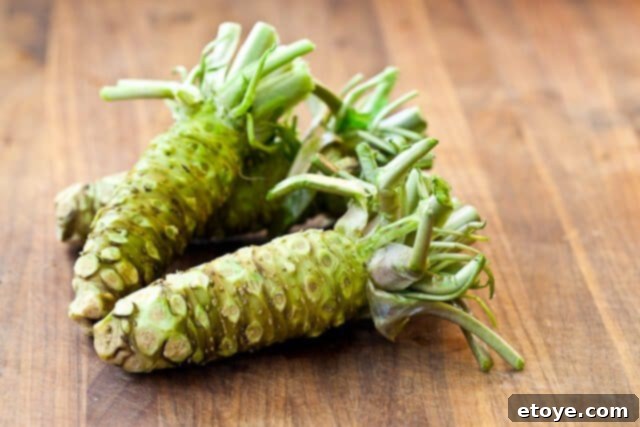
Through this article, we’ll uncover the secrets behind this elusive plant, explore its unique culinary applications, and appreciate the dedication required to bring it to discerning palates. Join us as we explore the world of true wasabi, a flavor revelation waiting to be discovered. ~Jaden
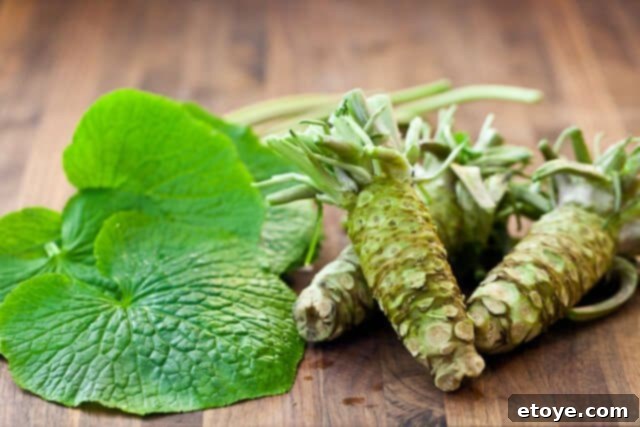
Discovering True Wasabi: Beyond the Imitation
by Tim Mar
Have you ever paused to consider why the fiery green paste accompanying your sushi often tastes remarkably similar to horseradish? The answer is surprisingly straightforward: because, in most cases, it *is* horseradish. The “wasabi” served in countless sushi establishments across North America, and indeed much of Japan, is predominantly a concoction of horseradish, vibrant green food coloring, a touch of hot mustard, and occasionally, a token amount of actual wasabi root. This widespread practice means that for many, the authentic taste of *Wasabia japonica* remains an unknown delight.
The reasons behind this prevalent substitution are rooted in the extreme scarcity and challenging cultivation of real wasabi. True wasabi root, scientifically known as *Wasabia japonica*, is exceptionally rare. Even in its native Japan, the demand consistently outstrips the limited supply, making it an expensive import. Furthermore, cultivating this delicate plant is notoriously tricky, requiring very specific environmental conditions that few regions outside of its natural habitat can provide. This confluence of factors makes genuine wasabi a rare find and an unparalleled taste experience—a culinary gem waiting to be discovered by those who seek out authentic flavors. Prepare to journey into the heart of this unique world.
Unveiling the Wasabi Sanctuary: A Glimpse into its Cultivation
It’s a crisp, overcast morning in May, deep within the Pacific Northwest, and I find myself peering through the muted light filtering through dark shade tarps into a sprawling greenhouse. Inside, an extraordinary sight unfolds: a dense, vibrant carpet of wasabi plants stretches as far as the eye can see, almost ready for harvest. The lush greenery creates an almost impenetrable sea, leaving barely enough room to navigate a path through the verdant expanse. The air is thick with the earthy, rich, and distinctly green aroma of the damp plants, a fragrant embrace that instantly signals the unique environment we’ve entered.

Our purpose here is to meet the dedicated individuals behind this verdant sanctuary: Brian, affectionately known as the “Wasabi Meister,” his wife Laurencia, and their insightful 10-year-old daughter, Aleena. They greet us warmly at one of their prime wasabi-growing sites, their faces reflecting the deep commitment and passion required for such an endeavor. As Aleena confidently leads us into the humid interior of the greenhouse, the heavy, verdant scent intensifies, wrapping us in the essence of living wasabi. We watch intently as Brian, with the practiced eye of a true artisan, selects a robust, bushy plant that has matured over years of meticulous care, now perfectly ripe for harvest.

With a gentle yet firm hand, Brian loosens the plant from its earthy bed using a specialized hoe, carefully extracting it—leaves, roots, and all—from the soil. He then carries his precious bounty outside to a purpose-built cleaning and preparation station, conveniently situated just beyond the greenhouse’s entrance. Here, under the open sky, the next stage of the wasabi journey begins.

After a thorough and refreshing washing in ample cold water, Brian’s skilled hands work deftly, trimming away the large, heart-shaped leaves, which he carefully saves—they are, surprisingly, edible and utterly delicious! He then removes the fibrous roots, and finally, presents us with the prize: a knobby, greenish, root-like object, typically three to six inches long. This is the highly sought-after, genuine wasabi rhizome, the true source of its legendary flavor. This rhizome, a specialized stem that grows primarily above ground, is the part of the plant that is traditionally grated to produce the iconic wasabi paste we associate with Japanese cuisine. It’s the part we’re used to *seeing*, but, as we’ve learned, rarely *tasting* in its authentic form.
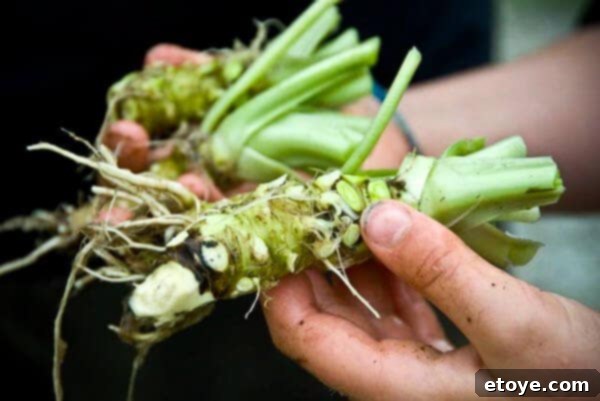
The rhizome, a fascinating botanical anomaly, grows horizontally near or just above the soil surface, distinguishing it from a true root. It is this unique morphology that contributes to its delicate flavor profile compared to its underground cousin, horseradish. Understanding this distinction is key to appreciating the subtle complexities of real wasabi.

With a palpable sense of pride, Aleena takes on the honor of grating the wasabi. Traditionally, a sharkskin grater, known as an *oroshi*, is considered the optimal tool, its fine texture creating the ideal paste consistency and maximizing flavor release. However, a high-quality ceramic grater also performs admirably, producing excellent results. While some culinary enthusiasts might attempt using a MICROPLANE zester, it’s worth noting that while it creates fine shavings, it doesn’t achieve the crucial mashing action that truly develops the fresh wasabi rhizome’s full aromatic potential. The goal is not just to grate, but to break down the cell walls sufficiently to allow the essential flavor compounds to react.

Within a mere minute, Aleena skillfully accumulates a small, pristine pile of grated wasabi, its color a natural, delicate shade of light green. This authentic hue is derived directly from chlorophyll, a vibrant contrast to the artificial dyes used in imitation pastes. Despite its root-like appearance, the above-ground growth of the rhizome ensures this beautiful, natural pigmentation. She meticulously gathers the shavings into a neat mound, and then, a crucial step: we allow it to rest for a precise one to two minutes. This brief pause is paramount, enabling the wasabi’s full flavor to develop. During this period, the flavor-producing compounds, primarily isothiocyanates, react upon grating and exposure to air. These compounds are exquisitely volatile, which means that the captivating pungency and invigorating heat of fresh wasabi rapidly diminishes, typically fading significantly within about 20 minutes. The golden rule of real wasabi is clear: it must be eaten freshly grated to experience its true, fleeting brilliance.
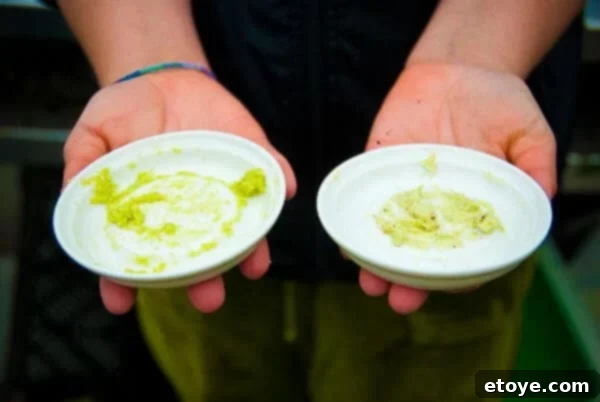
Finally, with anticipation building, we take a small amount on the tip of a chopstick and taste the freshly grated wasabi rhizome. The experience is nothing short of a revelation—a flavor profile unlike anything I’ve ever encountered. It possesses a powerful, invigorating heat, yet it is entirely devoid of the harshness or lingering burn often associated with horseradish-based imitations. Instead, it offers a remarkably clean, delicate, and distinctly herbal taste, evoking notes of green vegetation and a vibrant, almost sweet earthiness. This is the authentic taste of *Wasabia japonica*: a sophisticated, ephemeral spice that elevates any dish it graces, offering a truly pure and natural intensity.
The Culinary Delights of Authentic Wasabi
Imagine this exquisite, freshly grated wasabi paired with a meticulously prepared sushi plate – an unparalleled experience that elevates the delicate flavors of fresh fish and seasoned rice. But the culinary applications of true wasabi extend far beyond traditional Japanese cuisine. Its unique, clean heat and herbaceous notes make it a brilliant accompaniment to an array of dishes. Picture it delicately spread alongside perfectly grilled fish, lending a sophisticated zest that complements without overpowering. Envision it folded into a fresh lump crab salad, its subtle spice awakening the sweet succulence of the crab. Consider a small dollop melting atop steaming mashed potatoes, transforming a classic comfort food into a gourmet delight. Or, perhaps, serving it as an elegant coulis alongside a perfectly cooked steak, offering a vibrant counterpoint to rich, savory flavors. From enhancing the simplest fresh vegetables to elevating robust meats, fresh wasabi is a versatile and brilliant accompaniment that promises to intrigue and delight the palate. This unparalleled ingredient offers a depth and freshness that simply cannot be replicated by its imitations, ensuring a unique gastronomic adventure with every bite.
But wait, the marvels of the wasabi plant don’t end with the rhizome. Let’s not overlook the remarkable wasabi leaves and their long, crisp stems!
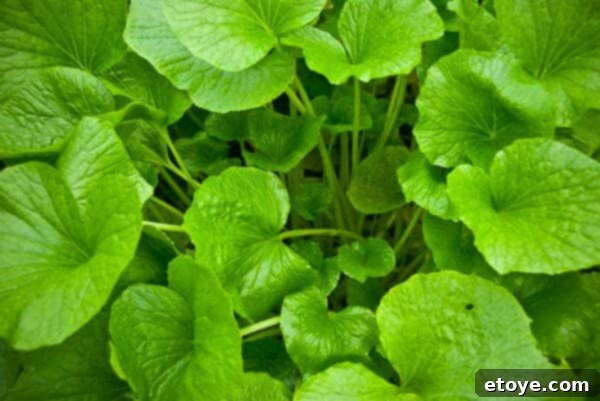
The large, beautifully heart-shaped leaves and their distinctively crisp stems, known as petioles, are not only edible but also exquisitely delicious. They offer a pleasantly spicy flavor, reminiscent of spicier varieties of salad greens, yet imbued with a distinct, subtle hint of that unmistakable wasabi essence. Their taste is both flavorful and wonderfully refreshing, with a touch of heat that, much like the grated rhizome, fades quickly, leaving a clean palate. Even more so than the rhizomes, these leaves are an extreme rarity outside of Japan, making them an incredibly sought-after ingredient for adventurous chefs and home cooks. What could be a more elegant and unexpected touch for your next springtime dinner party than a vibrant salad featuring these unique wasabi leaves? Their inclusion promises a memorable dish that showcases the entire bounty of this extraordinary plant.

The Chef’s Secret Weapon: Fresh Wasabi in Fine Dining
Brian and Laurencia’s exceptional fresh wasabi has quickly garnered an enthusiastic following among local chefs, who are particularly keen to incorporate this newly available, authentic ingredient into their creations. Their reputation has also spread far beyond the Pacific Northwest, a region renowned for its vibrant culinary scene and strong Asian-Pacific influences. They now collaborate with celebrated chefs from around the world, supplying some of the finest restaurants across the U.S. and Europe. Notably, a growing number of chefs at prestigious Michelin-rated establishments have become loyal customers, seeking out this unparalleled spice to elevate their dishes. Even as far afield as South Africa, one visionary chef provides fresh wasabi directly to diners, allowing them the unique experience of grating it themselves at the table to ensure the ultimate, fleeting freshness of its flavor. This tableside service perfectly highlights wasabi’s ephemeral nature, as its exquisite taste rapidly diminishes once exposed to air.
Beyond its classic role accompanying sushi and sashimi, innovative chefs are exploring a remarkable array of applications. They are skillfully pairing fresh wasabi with succulent oysters, using it to add a sophisticated kick to premium steaks, and even incorporating its delicate heat to flavor airy soufflés. These diverse applications underscore the versatility and unique appeal of real wasabi, proving it to be far more than just a condiment; it is a catalyst for culinary creativity, offering a distinct edge in the competitive world of fine dining.
Preserving Perfection: Storing Your Fresh Wasabi
Proper storage is crucial to maintaining the quality and flavor of your precious fresh wasabi. Here’s how to keep both rhizomes and leaves in optimal condition:
Rhizomes:
One highly effective method for storing wasabi rhizomes is to individually wrap each rhizome in a damp paper towel. Once wrapped, place them in a bowl and store them, uncovered, in the refrigerator. It is essential *not* to use plastic wrap or airtight containers, as the rhizomes require air circulation to prevent mold and maintain freshness. Be sure to keep the paper towels consistently damp, changing them as needed; under these conditions, your rhizomes will store exceptionally well for up to two weeks, sometimes even longer.
Alternatively, the renowned Iron Chef Masaharu Morimoto once shared a technique with me at the Aspen Food and Wine Classic: store the rhizomes submerged in ice water, changing the water daily. This method helps maintain hydration and freshness. You may notice the edges of the rhizomes darkening slightly over time, but this is a natural oxidation process. Simply scrape off the outermost layer with a vegetable peeler before grating to reveal the fresh, vibrant wasabi beneath.
Leaves and Petioles (Stems):
The delicate leaves and crisp petioles also store remarkably well in the refrigerator for approximately 10 days. To prepare them for storage, gently wash the leaves and petioles and leave them moist—do not dry them thoroughly. Then, place them in a plastic zip-type bag. The slight moisture retained will help keep them crisp and flavorful, ready to be added to salads or used as a unique garnish.
The Art of Preparing Fresh Wasabi Paste
Preparing authentic wasabi paste for immediate enjoyment is a wonderfully simple and engaging process. Begin by thoroughly washing the rhizome under cold water and carefully trimming away any small bumps or imperfections on its surface. Next, for a perfectly fresh grating surface, trim the root-end of the rhizome (while holding the leafy end upright). Once prepared, grate the wasabi into a small, neat pile. After grating, allow the pile to rest undisturbed for one to two minutes; this critical step permits the flavor compounds to fully develop and intensify, creating the signature wasabi pungency. Finally, serve it immediately to capture its peak flavor!
NOTE: Wasabi’s exquisite flavor is incredibly volatile and rapidly diminishes—typically within 15-20 minutes—once exposed to air. To combat this, gathering the fresh shavings into a compact ball not only makes it easier to use as a condiment but, more importantly, minimizes its exposure to oxygen, thereby preserving its potent flavor for a little longer.
TIP: If your wasabi has lost some of its initial pungency, you can easily revitalize it. Simply grate a small amount of fresh wasabi onto the existing pile, then gather everything into a ball again, gently rolling it between your fingers. Authentic wasabi should possess a natural stickiness, allowing it to easily maintain its ball-shape, indicating its freshness and optimal texture.
From Japan to the Pacific Northwest: A Wasabi Odyssey
Despite its incredible culinary appeal and burgeoning demand, Brian’s initial fascination with wasabi stemmed not from gastronomy, but from its profound potential health benefits. Until five years ago, Brian was a dedicated researcher and lecturer in botany at a university. It was during this period that he stumbled upon compelling information regarding wasabi’s potential anti-cancer properties, a discovery that resonated deeply with him, as he had recently experienced the loss of several family members to cancer. This personal tragedy fueled his scientific curiosity, transforming it into a passionate pursuit.
In 1993, driven by a blend of scientific inquiry and personal hope, Brian ordered his first batch of wasabi seeds from Japan and meticulously planted them. Unfortunately, this initial attempt ended in disappointment as the delicate seedlings quickly perished. Undeterred, he acquired a second batch, and this time, success! The seeds sprouted and began to grow. Fast-forward to today, bypassing years of relentless trial and error, countless experiments with varying growing conditions, and an unwavering commitment, the wasabi he cultivates is now absolutely top-notch. Through his pioneering efforts, this premium, fresh wasabi is now available year-round from his farms in the Americas, and can even be shipped overnight, making this once-elusive ingredient accessible to a wider audience.
*Wasabia japonica* is indigenous to Japan, where it has been cherished for centuries not only as a coveted delicacy but also for its recognized medicinal properties. So highly valued was wasabi that, according to ancient lore, Japanese shoguns would bestow wasabi plantations upon their valiant Samurai warriors as a profound gesture of gratitude for their exceptional service. In its wild habitat, wasabi thrives naturally in the cold, pristine beds of mountain streams. Traditional Japanese farmers ingeniously replicated these conditions, cultivating wasabi directly in streams, a method that yields robust and flavorful plants. This semi-aquatic cultivation, known as *sawa wasabi*, is widely considered superior in both flavor and character compared to soil-grown varieties. However, for Brian, cultivating wasabi directly within meandering streams was not a viable long-term option, even with controlled planting. “It’s not very linear,” he notes, emphasizing its incompatibility with the structured, systematic farming models prevalent in the Western world, characterized by neat, expansive fields. After years of intensive research and dedicated experimentation, Brian and his associates have successfully developed an innovative method of growing *sawa wasabi* that produces excellent results, bridging traditional Japanese cultivation with modern agricultural ingenuity.
Many believe wasabi to be an exceptionally difficult plant to cultivate. Brian, while acknowledging this perception, offers a comforting perspective: “It’s like baking a difficult cake; once you figure out the recipe, it’s not so hard.” However, as his own journey attests, discovering that precise “recipe” took many years of unwavering dedication and persistent effort. Even now, with their successful methods in place, Brian and his team continue to experiment, refine, and tweak their techniques, always striving for even greater perfection in their wasabi cultivation.
The Remarkable Health Benefits of Wasabi
Beyond its unparalleled culinary appeal, wasabi boasts a fascinating array of potential health benefits, many of which stem from its unique biochemical composition. In a published article in Naturopathy, Brian meticulously detailed some of these advantages, a summary of which is presented below:
- A Member of the Super-Healthy Cruciferous Family: Wasabi belongs to the highly esteemed cruciferous vegetable family, which includes nutritional powerhouses such as kale, cabbage, broccoli, cauliflower, Brussels sprouts, and mustard greens. This lineage alone suggests a wealth of beneficial compounds.
- Rich in Isothiocyanates (ITCs): The true magic of wasabi unfolds when it is ground up and mixed with water, or simply chewed. This process triggers a remarkable chemical reaction, converting a group of precursor compounds within fresh wasabi into potent isothiocyanates (ITCs). Much of the scientific research regarding wasabi’s health attributes has focused on the remarkable properties of these ITCs. It’s crucial to note that ITCs do not occur in dried wasabi; however, recent studies indicate that freeze-drying techniques can effectively preserve these compounds until they are ingested, making freeze-dried wasabi a viable option for therapeutic use.
- Powerful Antimicrobial Effects: In Japan, wasabi has long been revered for its perceived medicinal properties. Scientific investigation has revealed that ITCs possess the ability to inhibit the growth of certain strains of bacteria, yeast, and mold. It is widely believed that these potent antimicrobial effects are precisely why wasabi became an integral part of the traditional Japanese diet, serving as an effective natural complement to mitigate any potential ill effects associated with consuming raw fish. This culinary pairing wasn’t just about flavor; it was a deeply ingrained practice rooted in health and safety.
- Anti-Inflammatory Properties: Beyond its antimicrobial action, ITCs also exhibit significant anti-inflammatory effects. This suggests that wasabi may hold promise as a natural remedy for managing seasonal allergies and even asthma. Brian and his family are staunch advocates of this benefit, often sharing compelling anecdotes of friends and family members who have experienced substantial relief from these conditions through the use of wasabi, particularly in freeze-dried capsule form. Their personal experiences are now bolstered by recent clinical trials conducted in Japan, which lend scientific support to the efficacy of wasabi in alleviating seasonal allergies.
- Other Potential Benefits: Emerging research points to other intriguing potential benefits, including wasabi’s capacity to help prevent tooth decay and its possible efficacy in combating certain cancer cells. However, research in these areas has been somewhat limited, primarily due to the low availability of fresh wasabi and the considerable expense involved in obtaining it for scientific study. Brian hopes that his success in cultivating wasabi will significantly increase its availability, thereby paving the way for accelerated scientific research into its full spectrum of therapeutic possibilities, unlocking its secrets for global health benefits.
- Availability: While a rare find, fresh wasabi is occasionally available at some specialized and well-stocked Asian grocery stores, particularly those catering to discerning culinary palates.
Fresh Wasabi: The Whole Nine Yards
Understanding the wasabi plant means appreciating each of its valuable components:
Plants: A wasabi plant typically reaches maturity and is ready for harvest after at least 18 months of careful cultivation. At this stage, the bushy, leafy plants usually stand about knee-high, indicating their readiness. The entire plant is gently pulled from its bed, ensuring no part of this precious commodity is wasted.
Wasabi Rhizome: This is the highly coveted part of the plant. The rhizome, a thick, root-like stem, grows just above ground level. These knobby, distinctive rhizomes typically range in size from three to six inches long, and are the source of the fresh, pungent paste that defines true wasabi.
Leaves and Petioles: Often overlooked and virtually unknown in North America are the wasabi plant’s large, palm-sized leaves and their long, crisp, light-green stems, known as petioles. Both components are not only edible but are also deliciously flavorful. While they don’t possess the intense flavor of the rhizome, they offer a delightful, subtle spicy bite. These leaves and stems make an excellent and unique addition to salads, offering a refreshing zest that hints at the wasabi plant’s distinctive character.
